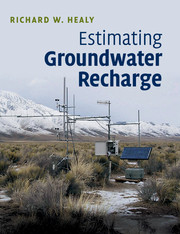Book contents
- Frontmatter
- Contents
- Preface
- Acknowledgments
- 1 Groundwater recharge
- 2 Water-budget methods
- 3 Modeling methods
- 4 Methods based on surface-water data
- 5 Physical methods: unsaturated zone
- 6 Physical methods: saturated zone
- 7 Chemical tracer methods
- 8 Heat tracer methods
- 9 Linking estimation methods to conceptual models of groundwater recharge
- References
- Index
5 - Physical methods: unsaturated zone
Published online by Cambridge University Press: 05 April 2013
- Frontmatter
- Contents
- Preface
- Acknowledgments
- 1 Groundwater recharge
- 2 Water-budget methods
- 3 Modeling methods
- 4 Methods based on surface-water data
- 5 Physical methods: unsaturated zone
- 6 Physical methods: saturated zone
- 7 Chemical tracer methods
- 8 Heat tracer methods
- 9 Linking estimation methods to conceptual models of groundwater recharge
- References
- Index
Summary
Introduction
Estimates of recharge can be obtained from measurement of downward water flux or change in water storage within the unsaturated zone. Methods based on physical (as opposed to chemical) data collected within the unsaturated zone are not among the more commonly used techniques for estimating recharge, but they offer some distinct advantages. The methods actually produce estimates of drainage rates below the depth of measurement within the unsaturated zone. The usual assumption is that the draining water will eventually reach the water table, at which time it can properly be called recharge. But there can be a long lag time over which water traverses that depth interval. Estimates generated by these methods are referred to as drainage in this chapter. In general, these methods produce point estimates of drainage. The question of how representative a measurement at a single point is of flux through the unsaturated zone as a whole requires careful consideration. These methods can be costly to implement and require intensive instrumentation that is susceptible to measurement inaccuracies. Nonetheless, under certain circumstances, such as rapid movement of a wetting front from land surface to a shallow water table, these methods have a unique ability to provide detailed insight into recharge processes and factors that influence recharge rates.
The methods can be divided into two classes: water-budget methods and methods based on the Darcy equation. Unsaturated-zone water budgets relate changes in the amount of water stored in the unsaturated zone to infiltration, drainage, and evapotranspiration. These methods include the zero-flux plane method and lysimetry. Included in the section on the zero-flux plane method is a discussion on measurement of water storage and change in storage within the unsaturated zone. Darcy methods require measurement or estimation of the hydraulic gradient and hydraulic conductivity at the ambient water content. Natural variability in hydraulic conductivity complicates the application of the Darcy method. Lysimeters can provide precise measurements of drainage rates, but the instruments can be expensive to install and maintain. A brief overview of techniques for measuring water content, pressure head, water-retention characteristics, and hydraulic conductivity of unsaturated-zone sediments, provided in Section 5.2, lays the groundwork for discussions of the zero-flux plane method (Section 5.3), the unsaturated-zone Darcy method (Section 5.4), and the use of lysimeters (Section 5.5).
- Type
- Chapter
- Information
- Estimating Groundwater Recharge , pp. 97 - 116Publisher: Cambridge University PressPrint publication year: 2010
- 1
- Cited by



